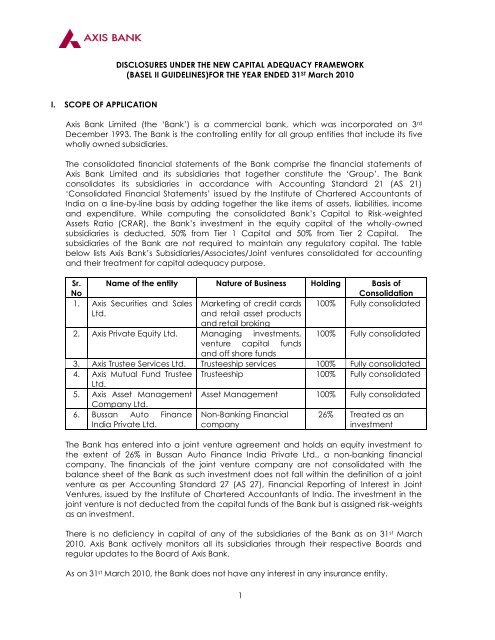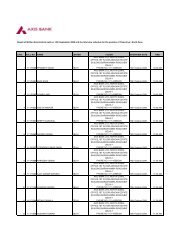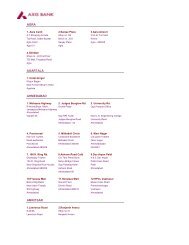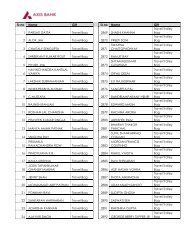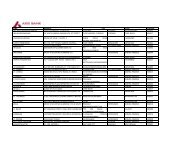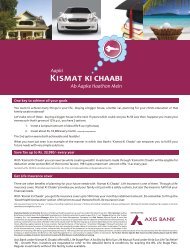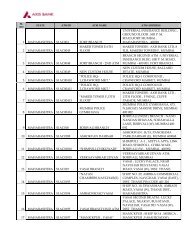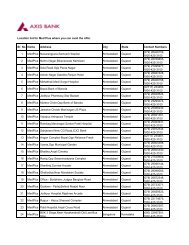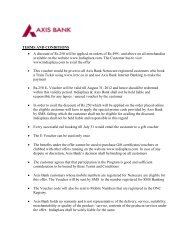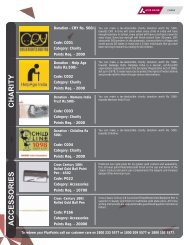Scope of Application
Scope of Application
Scope of Application
Create successful ePaper yourself
Turn your PDF publications into a flip-book with our unique Google optimized e-Paper software.
I. SCOPE OF APPLICATION<br />
DISCLOSURES UNDER THE NEW CAPITAL ADEQUACY FRAMEWORK<br />
(BASEL II GUIDELINES)FOR THE YEAR ENDED 31 ST March 2010<br />
Axis Bank Limited (the „Bank‟) is a commercial bank, which was incorporated on 3 rd<br />
December 1993. The Bank is the controlling entity for all group entities that include its five<br />
wholly owned subsidiaries.<br />
The consolidated financial statements <strong>of</strong> the Bank comprise the financial statements <strong>of</strong><br />
Axis Bank Limited and its subsidiaries that together constitute the „Group‟. The Bank<br />
consolidates its subsidiaries in accordance with Accounting Standard 21 (AS 21)<br />
„Consolidated Financial Statements‟ issued by the Institute <strong>of</strong> Chartered Accountants <strong>of</strong><br />
India on a line-by-line basis by adding together the like items <strong>of</strong> assets, liabilities, income<br />
and expenditure. While computing the consolidated Bank‟s Capital to Risk-weighted<br />
Assets Ratio (CRAR), the Bank‟s investment in the equity capital <strong>of</strong> the wholly-owned<br />
subsidiaries is deducted, 50% from Tier 1 Capital and 50% from Tier 2 Capital. The<br />
subsidiaries <strong>of</strong> the Bank are not required to maintain any regulatory capital. The table<br />
below lists Axis Bank‟s Subsidiaries/Associates/Joint ventures consolidated for accounting<br />
and their treatment for capital adequacy purpose.<br />
Sr. Name <strong>of</strong> the entity Nature <strong>of</strong> Business Holding Basis <strong>of</strong><br />
No<br />
Consolidation<br />
1. Axis Securities and Sales Marketing <strong>of</strong> credit cards 100% Fully consolidated<br />
Ltd.<br />
and retail asset products<br />
and retail broking<br />
2. Axis Private Equity Ltd. Managing investments, 100% Fully consolidated<br />
venture capital funds<br />
3. Axis Trustee Services Ltd.<br />
and <strong>of</strong>f shore funds<br />
Trusteeship services 100% Fully consolidated<br />
4. Axis Mutual Fund Trustee<br />
Ltd.<br />
Trusteeship 100% Fully consolidated<br />
5. Axis Asset Management<br />
Company Ltd.<br />
Asset Management 100% Fully consolidated<br />
6. Bussan Auto Finance Non-Banking Financial 26% Treated as an<br />
India Private Ltd.<br />
company<br />
investment<br />
The Bank has entered into a joint venture agreement and holds an equity investment to<br />
the extent <strong>of</strong> 26% in Bussan Auto Finance India Private Ltd., a non-banking financial<br />
company. The financials <strong>of</strong> the joint venture company are not consolidated with the<br />
balance sheet <strong>of</strong> the Bank as such investment does not fall within the definition <strong>of</strong> a joint<br />
venture as per Accounting Standard 27 (AS 27), Financial Reporting <strong>of</strong> Interest in Joint<br />
Ventures, issued by the Institute <strong>of</strong> Chartered Accountants <strong>of</strong> India. The investment in the<br />
joint venture is not deducted from the capital funds <strong>of</strong> the Bank but is assigned risk-weights<br />
as an investment.<br />
There is no deficiency in capital <strong>of</strong> any <strong>of</strong> the subsidiaries <strong>of</strong> the Bank as on 31 st March<br />
2010. Axis Bank actively monitors all its subsidiaries through their respective Boards and<br />
regular updates to the Board <strong>of</strong> Axis Bank.<br />
As on 31 st March 2010, the Bank does not have any interest in any insurance entity.<br />
1
II. CAPITAL STRUCTURE<br />
Summary<br />
As per RBI‟s capital adequacy norms capital funds are classified into Tier-1 and Tier-2<br />
capital. Tier-1 capital <strong>of</strong> the Bank consists <strong>of</strong> equity capital, statutory reserves, other<br />
disclosed free reserves, capital reserves and innovative perpetual debt instruments eligible<br />
for inclusion in Tier-1 capital that complies with requirement specified by RBI. The Tier II<br />
capital consists <strong>of</strong> general provision and loss reserves, upper Tier-2 instruments and<br />
subordinate debt instruments eligible for inclusion in Tier-2 capital. Axis Bank has issued debt<br />
instruments that form a part <strong>of</strong> Tier-1 and Tier-2 capital. The terms and conditions that are<br />
applicable for these instruments comply with the stipulated regulatory requirements.<br />
Tier-1 bonds are non-cumulative and perpetual in nature with a call option after 10 years.<br />
Interest on Tier-1 bonds is payable either annually or semi-annually. Some <strong>of</strong> the Tier-1<br />
bonds have a step-up clause on interest payment ranging up to 100 bps. The Upper Tier-2<br />
bonds have an original maturity <strong>of</strong> 15 years with a call option after 10 years. The interest on<br />
Upper Tier-2 bonds is payable either annually or semi-annually. Some <strong>of</strong> the Upper Tier-2<br />
debt instruments have a step-up clause on interest payment ranging up to 100 bps. The<br />
Lower Tier-2 bonds have an original maturity between 5 to 10 years. The interest on lower<br />
Tier-2 capital instruments is payable either semi-annually or annually.<br />
Equity Capital<br />
The Bank has authorized share capital <strong>of</strong> Rs. 500.00 crores comprising 50,00,00,000 equity<br />
shares <strong>of</strong> Rs. 10/- each. As on 31 st March 2010 the Bank has issued, subscribed and paid-up<br />
equity capital <strong>of</strong> Rs. 405.17 crores, constituting 40,51,74,119 number <strong>of</strong> shares <strong>of</strong> Rs. 10/-<br />
each. The Bank‟s shares are listed on the National Stock Exchange and the Bombay Stock<br />
Exchange. The GDRs issued by the Bank are listed on the London Stock Exchange (LSE).<br />
During the year ended 31 March 2010, the Bank raised additional equity capital in the form<br />
<strong>of</strong> 50,55,500 Global Depository Receipts (GDRs) (each GDR representing 1 underlying<br />
equity share <strong>of</strong> Rs. 10/- each), at a price <strong>of</strong> US$ 18.90 per GDR. The Bank also undertook a<br />
Qualified Institutional Placement (QIP) <strong>of</strong> 3,30,44,500 shares and a preferential allotment <strong>of</strong><br />
39,76,632 shares at a price <strong>of</strong> Rs. 906.70 per share. As a consequence, the paid-up share<br />
capital <strong>of</strong> the Bank has increased by Rs. 42.08 crores and the reserves <strong>of</strong> the Bank have<br />
increased by Rs. 3,725.64 crores after charging <strong>of</strong> issue related expenses.<br />
During the year, the Bank has also allotted equity shares to employees under its Employee<br />
Stock Option Plan.<br />
The provisions <strong>of</strong> the Companies Act, 1956 and other applicable laws and regulations<br />
govern the rights and obligations <strong>of</strong> the equity share capital <strong>of</strong> the Bank.<br />
Debt Capital Instruments<br />
The Bank has raised capital through Innovative Perpetual Debt Instrument (IPDI) eligible as<br />
Tier 1 Capital and Tier 2 Capital in the form <strong>of</strong> Upper Tier 2 and Sub-ordinated bonds<br />
(unsecured redeemable non-convertible debentures), details <strong>of</strong> which are given below.<br />
2
Perpetual Debt Instrument<br />
The Bank has raised Perpetual Debt Instruments eligible as Tier 1 Capital, the aggregate<br />
value <strong>of</strong> which as on 31 st March 2010 was Rs. 420.54 crores as stated below.<br />
Date <strong>of</strong> Allotment Rate <strong>of</strong> Interest Period Amount<br />
30 September 2006 10.05% Perpetual Rs. 214.00 crores<br />
15 November 2006 7.167% Perpetual USD 46 million*<br />
(Rs. 206.54 crores)<br />
Total Perpetual Debt Rs. 420.54 crores<br />
*Converted to INR @ Rs. 44.90 to a US Dollar (prevailing exchange rate as on 31.3.2010)<br />
Upper Tier 2 Capital<br />
The Bank has also raised Upper Tier 2 Capital, the aggregate value <strong>of</strong> which as on 31 st<br />
March 2010 was Rs. 1,248.98 crores as per the table below.<br />
Date <strong>of</strong> Allotment Date <strong>of</strong> Redemption<br />
Rate <strong>of</strong><br />
Interest<br />
Amount<br />
11 August 2006 10 August 2021 7.25% USD 149.85 million*<br />
(Rs. 672.81 crores)<br />
24 November 2006 23 November 2021 9.35% Rs. 200.00 crores<br />
6 February 2007 6 February 2022 9.50% Rs. 107.50 crores<br />
28 June 2007 28 June 2022 7.125% USD 59.84 million*<br />
(Rs. 268.67 crores)<br />
Total Upper Tier 2 Capital Rs. 1,248.98 crores<br />
*Converted to INR @ Rs 44.90 to a US Dollar (prevailing exchange rate as on 31.3.2010)<br />
Subordinated Debt<br />
As on 31 st March 2010, the Bank had an outstanding Subordinated debt (unsecured<br />
redeemable non-convertible debentures) aggregating Rs. 5,486.30 crores. Of this, Rs.<br />
4,842.70 crores qualified as Lower Tier 2 capital, the details <strong>of</strong> which are stated below.<br />
3<br />
(Rs. in crores)<br />
Date <strong>of</strong> Allotment Date <strong>of</strong> Redemption Rate <strong>of</strong> Interest Amount<br />
20 September 2002 20 June 2010 9.05% 5.00<br />
20 September 2002 20 June 2012 9.30% 62.00<br />
21 December 2002 21 September 2012 8.95% 60.00<br />
26 July 2003 26 April 2011 6.70% 5.00<br />
26 July 2003 26 April 2013 7.00% 65.00<br />
15 January 2004 15 October 2013 6.50% 50.00<br />
4 June 2004 4 June 2010 One-year G-sec semiannual<br />
yield plus a<br />
margin <strong>of</strong> 85 basis<br />
points to be reset at<br />
semi-annual intervals.<br />
150.00<br />
25 July 2005 25 July 2012 Simple average <strong>of</strong> Mid 500.00
Date <strong>of</strong> Allotment Date <strong>of</strong> Redemption Rate <strong>of</strong> Interest Amount<br />
4<br />
<strong>of</strong> Bid and <strong>of</strong>fer yield <strong>of</strong><br />
the 1-year GOI benchmark<br />
(i.e. INBMK) plus a<br />
margin <strong>of</strong> 65 basis<br />
points to be reset at<br />
semi annual intervals.<br />
22 March 2006 22 June 2013 8.50% 125.00<br />
22 March 2006 22 June 2013 8.32% 5.00<br />
22 March 2006 22 March 2016 8.75% 360.00<br />
22 March 2006 22 March 2016 8.56% 10.00<br />
28 June 2006 28 September 2013 8.95% 33.50<br />
28 June 2006 28 June 2016 9.10% 104.90<br />
30 March 2007 30 March 2017 10.10% 250.90<br />
7 November 2008 7 November 2018 11.75% 1,500.00<br />
28 March 2009 28 March 2019 9.95% 200.00<br />
16 June 2009 16 June 2019 9.15% 2,000.00<br />
Total 5,486.30<br />
During the year, subordinated debt (unsecured redeemable non-convertible subordinated<br />
debentures) <strong>of</strong> Rs 2,000 crores was raised.<br />
Capital Funds<br />
Position as on 31 st March 2010<br />
(Rs. in crores)<br />
Amount<br />
Tier 1 Capital<br />
Of which<br />
15,789.42<br />
- Paid-up Share Capital 405.17<br />
- Reserves and surplus (Excluding Foreign Currency<br />
15,632.32<br />
A Translation Reserve)<br />
- Innovative Perpetual Debt Instruments<br />
- Amount deducted from Tier 1 capital<br />
420.54<br />
- Investments in subsidiaries (57.28)<br />
- Deferred Tax Assets (611.33)<br />
B Tier 2 Capital (net <strong>of</strong> deductions) (B.1+B.2+B.3-B.4)<br />
Out <strong>of</strong> above<br />
Debt Capital Instruments eligible for inclusion as Upper Tier 2<br />
Capital<br />
6,518.47<br />
B.1 - Total amount outstanding 1,248.98<br />
- Of which amount raised during the current year -<br />
- Amount eligible as capital funds 1,248.98<br />
B.2 Subordinated debt eligible for inclusion in Lower Tier 2 Capital<br />
- Total amount outstanding 5,486.30<br />
- Of which amount raised during the current year 2,000.00<br />
- Amount eligible as capital funds 4,842.70<br />
B.3 Other Tier 2 Capital - Provision for Standard Assets 484.07
B.4<br />
Deductions from Tier 2 Capital<br />
- Investments in Subsidiaries (57.28)<br />
C Total Eligible Capital 22,307.89<br />
III. CAPITAL ADEQUACY<br />
Axis Bank is subject to the capital adequacy guidelines stipulated by RBI, which are based<br />
on the framework <strong>of</strong> the Basel Committee on Banking Supervision. As per the capital<br />
adequacy guidelines under Basel I, the Bank is required to maintain a minimum ratio <strong>of</strong><br />
total capital to risk weighted assets (CRAR) <strong>of</strong> 9.0%, at least half <strong>of</strong> which is required to be<br />
Tier 1 Capital. In June 2008, RBI issued the Master Circular – Prudential Guidelines on Capital<br />
Adequacy and Market Discipline on Basel II. As per Basel II guidelines, Axis Bank is required<br />
to maintain a minimum CRAR <strong>of</strong> 9.0%, with minimum Tier 1 Capital ratio <strong>of</strong> 6.0%. In terms <strong>of</strong><br />
RBI guidelines for implementation <strong>of</strong> Basel II, capital charge for credit and market risk for<br />
the financial year ended 31 st March 2010 will be required to be maintained at the higher<br />
levels implied by Basel II or 80% <strong>of</strong> the minimum capital requirement computed as per the<br />
Basel I framework. For the year ended 31 st March 2010, the minimum capital required to<br />
be maintained by Axis Bank as per Basel II guidelines is higher than that under Basel I<br />
guidelines.<br />
An assessment <strong>of</strong> the capital requirement <strong>of</strong> the Bank is carried out through a<br />
comprehensive projection <strong>of</strong> future businesses that takes cognizance <strong>of</strong> the strategic<br />
intent <strong>of</strong> the Bank, pr<strong>of</strong>itability <strong>of</strong> particular businesses and opportunities for growth. The<br />
proper mapping <strong>of</strong> credit, operational and market risks to this projected business growth<br />
enables assignment <strong>of</strong> capital that not only adequately covers the minimum regulatory<br />
capital requirement but also provides headroom for growth. The calibration <strong>of</strong> risk to<br />
business is enabled by a strong risk culture in the Bank aided by effective, technologybased<br />
risk management systems. A summary <strong>of</strong> the Bank‟s capital requirement for credit,<br />
market and operational risk and the capital adequacy ratio as on 31 st March 2010 is<br />
presented below.<br />
(Rs. in crores)<br />
Capital Requirements for various Risks<br />
5<br />
Amount<br />
CREDIT RISK<br />
Capital requirements for Credit Risk<br />
- Portfolios subject to standardized approach 11,040.47<br />
- Securitisation exposures -<br />
MARKET RISK<br />
Capital requirements for Market Risk<br />
- Standardized duration approach 1,008.72<br />
- Interest rate risk 851.99<br />
- Foreign exchange risk (including gold) 127.62<br />
- Equity risk 29.11<br />
OPERATIONAL RISK<br />
Capital requirements for Operational risk<br />
- Basic indicator approach 656.09<br />
Capital Adequacy Ratio <strong>of</strong> the Bank (%) 15.80%<br />
Tier 1 CRAR (%) 11.18%
IV. RISK MANAGEMENT: OBJECTIVES AND ORGANIZATION STRUCTURE<br />
The wide variety <strong>of</strong> businesses undertaken by the Bank requires it to identify, measure,<br />
control, monitor and report risks effectively. The key components <strong>of</strong> the Bank‟s risk<br />
management rely on the risk governance architecture, comprehensive processes and<br />
internal control mechanism. The Bank‟s risk governance architecture focuses attention on<br />
key areas <strong>of</strong> risk such as credit, market and operational risk and quantification <strong>of</strong> these risks<br />
wherever possible for effective and continuous monitoring.<br />
Objectives and Policies<br />
The Bank's risk management processes are guided by well-defined policies appropriate for<br />
various risk categories, independent risk oversight and periodic monitoring through the subcommittees<br />
<strong>of</strong> the Board <strong>of</strong> Directors. The Board sets the overall risk appetite and<br />
philosophy for the Bank. The Committee <strong>of</strong> Directors, the Risk Management Committee<br />
and the Audit Committee <strong>of</strong> the Board, which are sub-committees <strong>of</strong> the Board, review<br />
various aspects <strong>of</strong> risk arising from the businesses <strong>of</strong> the Bank. Various senior management<br />
committees, Credit Risk Management Committee (CRMC), Asset-Liability Committee<br />
(ALCO) and Operational Risk Management Committee (ORMC) operate within the broad<br />
policy framework as illustrated below.<br />
Board level<br />
committees<br />
Credit Committees &<br />
Investment<br />
Committees<br />
Committee <strong>of</strong><br />
Directors<br />
The Bank has also formulated a global risk policy for overseas operations and a country<br />
specific risk policy for its Singapore, Hong Kong and Dubai branches. The policies were<br />
drawn based on the risk dimensions <strong>of</strong> dynamic economies and the Bank's risk appetite.<br />
The Bank has formulated a comprehensive Stress Testing policy to measure impact <strong>of</strong><br />
adverse stress scenarios on the adequacy <strong>of</strong> capital.<br />
Structure and Organization<br />
ALCO<br />
Board <strong>of</strong> Directors<br />
Risk Management<br />
Committee <strong>of</strong> the Board<br />
Operational Risk<br />
Management<br />
Committee<br />
Risk Management Department reports to the Deputy Managing Director and the Risk<br />
Management Committee <strong>of</strong> the Board oversees the functioning <strong>of</strong> the Department. The<br />
Department has three separate teams for Credit Risk, Market Risk and Operational Risk and<br />
the head <strong>of</strong> each team reports to the head <strong>of</strong> the department.<br />
Head <strong>of</strong> Risk<br />
6<br />
Credit Risk<br />
Management<br />
Committee<br />
Audit Committee<br />
Committee <strong>of</strong><br />
Executives<br />
Credit Risk Operational Risk<br />
Market risk
V. CREDIT RISK<br />
Credit Risk Management Policy<br />
Credit risk covers the inability <strong>of</strong> a borrower or counter-party to honour commitments under<br />
an agreement and any such failure has an adverse impact on the financial performance<br />
<strong>of</strong> the Bank. The Bank is exposed to credit risk through lending and capital market<br />
activities.<br />
The Bank‟s credit risk management process integrates risk management into the business<br />
management processes, while preserving the independence and integrity <strong>of</strong> risk<br />
assessment. The goal <strong>of</strong> credit risk management during the year has been to maintain a<br />
healthy credit portfolio by managing risk at the portfolio level as well as at the individual<br />
transaction level. The Board <strong>of</strong> Directors establishes the parameters for risk appetite, which<br />
is defined quantitatively and qualitatively in accordance with the laid-down strategic<br />
business plan. The foundation <strong>of</strong> credit risk management rests on the internal rating system.<br />
Credit Rating System<br />
Internal reporting and oversight <strong>of</strong> assets is principally differentiated by the credit ratings<br />
applied. The Bank has developed rating tools specific to market segments such as large<br />
corporates, mid-corporates, SME, financial companies and micr<strong>of</strong>inance companies to<br />
objectively assess underlying risk associated with such exposures. For retail and schematic<br />
SME exposures, scorecards and borrower-scoring templates are used for application<br />
screening. Hence, for these exposures, the credit risk is measured and managed at the<br />
portfolio level. The Bank is also trying to use internal database <strong>of</strong> retail loans for building up<br />
statistical behavioural scorecards as well as for refining credit assessment at the<br />
application sourcing level.<br />
The credit rating tool uses a combination <strong>of</strong> quantitative inputs and qualitative inputs to<br />
arrive at a 'point-in-time' view <strong>of</strong> the rating <strong>of</strong> counterparty. The monitoring tool developed<br />
by the Bank helps in objectively assessing the credit quality <strong>of</strong> the borrower taking into<br />
cognizance the actual behaviour post-disbursement. The output <strong>of</strong> the rating model is<br />
primarily to assess the chances <strong>of</strong> delinquency over a one-year time horizon. Each internal<br />
rating grade corresponds to a distinct probability <strong>of</strong> default. Model validation is carried out<br />
periodically by objectively assessing its calibration accuracy and stability <strong>of</strong> ratings.<br />
Credit Sanction and related processes<br />
The Bank has put in place the following hierarchical committee structure for credit sanction<br />
and review:<br />
� Zonal Office Credit Committee (ZOCC)<br />
� Central Office Credit Committee (COCC)<br />
� Committee <strong>of</strong> Executives (COE)<br />
� Senior Management Committee (SMC)<br />
� Committee <strong>of</strong> Directors (COD)<br />
The guiding principles behind the credit sanction process are us under.<br />
� „Know your Customer‟ is a leading principle for all activities.<br />
� Sound credit approval process with well laid credit-granting criteria.<br />
7
� The acceptability <strong>of</strong> credit exposure is primarily based on the sustainability and<br />
adequacy <strong>of</strong> borrower‟s normal business operations and not based solely on the<br />
availability <strong>of</strong> security.<br />
� Portfolio level risk analytics and reporting to ensure optimal spread <strong>of</strong> risk across various<br />
rating classes prevent undue risk concentration across any particular industry segments<br />
and monitor credit risk quality migration.<br />
� Sector specific studies are periodically undertaken to highlight risk and opportunities in<br />
those sectors.<br />
� Rating linked exposure norms have been adopted by the Bank.<br />
� Industry-wise exposure ceilings are based on the industry performance, prospects and<br />
the competitiveness <strong>of</strong> the sector.<br />
� Separate risk limits are set up for credit portfolios like advances to NBFC and unsecured<br />
loans that require special monitoring.<br />
� With heightened activity in the real estate sector, the Bank has strengthened its risk<br />
management systems to ensure that its advances are to borrowers having a good<br />
track record and satisfying the criterion <strong>of</strong> minimum acceptable credit rating.<br />
Appropriate covenants are stipulated for risk containment and monitoring.<br />
Review and Monitoring<br />
� All credit exposures, once approved, are monitored and reviewed periodically against<br />
the approved limits. Borrowers with lower credit rating are subject to more frequent<br />
reviews.<br />
� Credit audit involves independent review <strong>of</strong> credit risk assessment, compliance with<br />
internal policies <strong>of</strong> the Bank and with the regulatory framework, compliance <strong>of</strong><br />
sanction terms and conditions and effectiveness <strong>of</strong> loan administration.<br />
� Customers with emerging credit problems are identified early and classified<br />
accordingly. Remedial action is initiated promptly to minimize the potential loss to the<br />
Bank.<br />
Portfolio Management<br />
The Bank continues to track the quality <strong>of</strong> all portfolios through appropriate risk metrics.<br />
Periodic delinquency reporting, vintage analysis <strong>of</strong> the portfolio and rating-wise distribution<br />
<strong>of</strong> its borrowers provides insight for future course <strong>of</strong> action.<br />
In the backdrop <strong>of</strong> the economic slowdown, the Bank has pursued a strategy <strong>of</strong> growth<br />
with consolidation <strong>of</strong> asset quality. The exposure to sectors that had been most affected<br />
by the downturn were kept under control and there was an increased focus on borrowers<br />
having good and stable rating.<br />
During the year the Bank has been selective in choosing a growth path for retail assets. The<br />
focus has been on increasing lending to secured portfolios (mortgage, auto), while<br />
maintaining a cautious approach to unsecured lending (personal loans and credit card<br />
business). Move has been to improve the quality <strong>of</strong> incremental origination through tighter<br />
credit underwriting standards, increased use <strong>of</strong> bureau level data and leveraging on<br />
internal customer base <strong>of</strong> the Bank for cross sell. Account management and focus on<br />
collection are a priority to control delinquencies at the portfolio level.<br />
8
Concentration Risk<br />
The Bank controls and limits concentration risk by means <strong>of</strong> appropriate structural limits and<br />
borrower limits based on creditworthiness. These include:<br />
Large Exposures to Individual Clients or Group<br />
The Bank has individual borrower-wise exposure ceilings based on the internal rating <strong>of</strong> the<br />
borrower as well as group-wise borrowing limits. The Bank monitors the level <strong>of</strong> credit risk<br />
(Low/Moderate/High/Very High) and direction <strong>of</strong> change in credit risk (increasing<br />
/decreasing/stable) at the portfolio level based on the following six parameters that<br />
capture concentration risk.<br />
� Highest geographic concentration in a region.<br />
� Exposure to Top 20 accounts as a percentage <strong>of</strong> Credit Risk Exposure (CRE).<br />
� Percentage <strong>of</strong> term loans with residual maturity more than 3 years to total loans and<br />
advances.<br />
� Percentage <strong>of</strong> unsecured loans to total loan and advances.<br />
� Number <strong>of</strong> single borrower exposures exceeding 15% <strong>of</strong> capital funds.<br />
� Number <strong>of</strong> group exposures exceeding 40% <strong>of</strong> capital funds.<br />
While determining level and direction <strong>of</strong> credit risk, parameters like percentage <strong>of</strong> low- risk<br />
credit (investment grade and above) to credit risk exposure and migration from investment<br />
to non-investment grade (quantum as percentage <strong>of</strong> credit risk exposure) are also<br />
considered.<br />
Industries<br />
Industry analysis plays an important part in assessing the concentration risk within the loan<br />
portfolio. Particular attention is given to industry sectors where the Bank believes there is a<br />
high degree <strong>of</strong> risk or potential for volatility in the future. The Bank has fixed internal limits for<br />
aggregate commitments to different sectors so that the exposures are evenly spread over<br />
various sectors.<br />
Policies for Hedging and Mitigating Credit Risk<br />
Credit Risk Mitigants (CRM) like financial collateral, non-financial collateral and guarantees<br />
are used to mitigate credit risk exposure. Availability <strong>of</strong> CRM either reduces effective<br />
exposure on the borrower (in case <strong>of</strong> collaterals) or transfers the risk to the more<br />
creditworthy party (in case <strong>of</strong> guarantees). A major part <strong>of</strong> the eligible financial collaterals<br />
is in the form <strong>of</strong> cash, the most liquid <strong>of</strong> assets and thus free from any market and liquidity<br />
risks. The Bank has formulated a Collateral Management Policy as required under Basel II<br />
guidelines.<br />
Credit Risk Asset Quality<br />
Distribution <strong>of</strong> Credit Risk by Asset Quality<br />
Rating scale for large and mid corporates is a 14-point granular scale that ranges from AB-<br />
AAA to AB-D. The rating tool for SME has an 8-point rating scale, ranging from SME 1 to SME<br />
8. There are separate rating tools for financial companies and schematic SME and retail<br />
agricultural exposures.<br />
9
Definitions <strong>of</strong> Non-Performing Assets<br />
Advances are classified into performing and non-performing advances (NPAs) as per RBI<br />
guidelines. NPAs are further classified into sub-standard, doubtful and loss assets based on<br />
the criteria stipulated by RBI. An asset, including a leased asset, becomes non-performing<br />
when it ceases to generate income for the Bank.<br />
An NPA is a loan or an advance where:<br />
1. interest and/or instalment <strong>of</strong> principal remains overdue for a period <strong>of</strong> more than 90<br />
days in respect <strong>of</strong> a term loan;<br />
2. the account remains "out-<strong>of</strong>-order'' in respect <strong>of</strong> an Overdraft or Cash Credit (OD/CC);<br />
3. the bill remains overdue for a period <strong>of</strong> more than 90 days in case <strong>of</strong> bills purchased<br />
and discounted;<br />
4. A loan granted for short duration crops will be treated as an NPA if the installments <strong>of</strong><br />
principal or interest thereon remain overdue for two crop seasons; and<br />
5. a loan granted for long duration crops will be treated as an NPA if the installments <strong>of</strong><br />
principal or interest thereon remain overdue for one crop season.<br />
6. In respect <strong>of</strong> derivative transactions, the overdue receivables representing positive<br />
mark-to-market value <strong>of</strong> a derivative contract, if these remain unpaid for a period <strong>of</strong> 90<br />
days from the specified due date for payment.<br />
Definition <strong>of</strong> Impairment<br />
At each balance sheet date, the Bank ascertains if there is any impairment in its assets. If<br />
such an indication is detected, the Bank estimates the recoverable amount <strong>of</strong> the asset. If<br />
the recoverable amount <strong>of</strong> the asset or the cash-generating unit, which the asset belongs<br />
to, is less than its carrying amount, the carrying amount is reduced to its recoverable<br />
amount. The reduction is treated as an impairment loss and is recognized in the pr<strong>of</strong>it and<br />
loss account.<br />
CREDIT RISK EXPOSURES<br />
Total Gross Credit Risk Exposure Including Geographic Distribution <strong>of</strong> Exposure – Position as<br />
on 31 st March 2010<br />
(Rs. in crores)<br />
Domestic Overseas Total<br />
Fund Based 142,765.19 13,333.59 156,098.78<br />
Non Fund Based * 51,433.76 2,666.97 54,100.73<br />
Total 194,198.95 16,000.56 210,199.51<br />
* Non-fund based exposures are guarantees given on behalf <strong>of</strong> constituents and<br />
acceptances and endorsements.<br />
10
Distribution <strong>of</strong> Credit Risk Exposure by Industry Sector – Position as on 31 st March 2010<br />
Sr.<br />
No.<br />
Industry Classification<br />
11<br />
(Rs. in crores)<br />
Amount<br />
Fund Based Non-Fund<br />
Based<br />
1. Coal 61.14 139.13<br />
2. Mining 722.31 1,029.21<br />
3. Iron and Steel 3,709.07 2,680.64<br />
4. Other Metal and Metal Products 1,020.01 1,008.49<br />
5. All Engineering 2,361.55 3,179.17<br />
- Of which Electronics 255.92 52.33<br />
6. Electricity (Power Generation & Distribution) 4,094.97 4,352.03<br />
7. Cotton Textiles 2,380.39 382.35<br />
8. Jute Textiles 7.50 0.29<br />
9. Other Textiles 1,125.92 297.78<br />
10. Sugar 668.58 555.11<br />
11. Tea 263.61 4.30<br />
12. Food Processing 3,819.88 194.06<br />
13. Vegetable Oil and Vanspati 701.83 2,273.05<br />
14. Tobacco and Tobacco Products 242.84 9.94<br />
15. Paper and Paper Products 1,195.81 200.42<br />
16. Rubber and Rubber Products 395.27 116.26<br />
17. Chemicals, Dyes, Paints etc. 3,675.13 2,208.37<br />
- Of which Drugs & Pharmaceuticals 1,452.83 371.01<br />
18. Cement 1,816.61 395.35<br />
19. Leather and Leather Products 124.21 5.08<br />
20. Gems and Jewellery 1,818.17 9,964.71<br />
21. Construction 5,176.29 345.97<br />
22. Petrochemicals and Petroleum Products 2,151.32 1,932.51<br />
23. Automobiles including trucks 2,083.55 390.49<br />
24. Computer S<strong>of</strong>tware 1,936.56 471.41<br />
25. Infrastructure 9,069.49 9,775.60<br />
- Of which Infrastructure construction Roads 1,542.56 822.69<br />
- Of which Infrastructure construction Ports 682.27 1,222.84<br />
- Of which Telecommunication 2,195.30 1,929.57<br />
26. NBFCs & Trading 15,553.22 4,309.07<br />
27. Other Industries 21,739.82 6,431.87<br />
- Of which Banks 6,373.90 3,300.53<br />
- Of which Entertainment Media 1,105.98 445.00<br />
- Of which Logistics 1,423.42 498.14<br />
28. Residual exposures to balance the total exposure 68,183.74 1,448.06<br />
Total 156,098.78 54,100.73<br />
As on 31st March 2010, the Bank‟s exposure to the industries stated below was more than<br />
5% <strong>of</strong> the total gross credit exposure:<br />
Sr.<br />
Industry Classification Percentage <strong>of</strong> the total<br />
No.<br />
gross credit exposure<br />
1. NBFCs and Trading 9%<br />
2. Infrastructure 9%<br />
2. Gems and Jewellery 6%
Residual Contractual Maturity breakdown <strong>of</strong> Assets – Position as on 31 st March 2010<br />
Cash, balances<br />
(Rs. in crores)<br />
Other assets<br />
Maturity Bucket with RBI and Investments Advances including<br />
other banks<br />
fixed assets<br />
1day 3,200.91 885.56 736.72 -<br />
2 to 7 days 1,043.07 986.17 2,413.13 71.79<br />
8 to 14 days 1,013.50 2,562.54 1,124.78 10.36<br />
15 to 28 days 1,403.04 3,991.38 1,057.75 1,215.68<br />
29 days to 3 months 2,632.78 7,724.61 5,690.32 -<br />
3 to 6 months 967.68 6,278.44 5,557.00 -<br />
6 to 12 months 2,060.72 7,873.42 11,183.25 -<br />
1 to 3 years 1,402.90 11,403.71 11,861.43 -<br />
3 to 5 years 19.70 2,436.83 12,318.65 -<br />
Over 5 years 1,462.14 11,832.16 52,400.09 3,825.65<br />
Total 15,206.44 55,974.82 104,343.12 5,123.48<br />
Movement <strong>of</strong> NPAs and Provision for NPAs – Position as on 31 st March 2010<br />
(Rs. in crores)<br />
Amount<br />
Amount <strong>of</strong> NPAs (Gross)<br />
- Substandard 643.57<br />
A.<br />
- Doubtful 1<br />
- Doubtful 2<br />
67.37<br />
26.09<br />
- Doubtful 3 15.04<br />
- Loss 565.93<br />
B. Net NPAs 419.00<br />
C. NPA Ratios<br />
- Gross NPAs to gross advances (%) 1.25%<br />
- Net NPAs to net advances (%)<br />
Movement <strong>of</strong> NPAs (Gross)<br />
0.40%<br />
- Opening balance as on 1.4.2009 897.77<br />
D. - Additions 1,800.70<br />
- Reductions (1,380.47)<br />
- Closing balance as on 31.3.2010<br />
Movement <strong>of</strong> Provision for NPAs<br />
1,318.00<br />
- Opening balance as on 1.4.2009 570.64<br />
E.<br />
- Provision made in 2009-10<br />
- Write – <strong>of</strong>fs / Write – back <strong>of</strong> excess provision<br />
1,373.21<br />
(1,041.60)<br />
- Reclassification <strong>of</strong> floating provision (3.25)<br />
- Closing balance as on 31.3.2010 899.00<br />
NPIs and Movement <strong>of</strong> Provision for Depreciation on NPIs – Position as on 31 st March 2010<br />
(Rs. in crores)<br />
Amount<br />
A. Amount <strong>of</strong> Non-Performing Investments 22.58<br />
B. Amount <strong>of</strong> Provision held for Non- performing investments 16.18<br />
C. Movement <strong>of</strong> provision for depreciation on investments<br />
12
- Opening balance as on 1.4.2009 200.00<br />
- Provision made in 2009-10 40.98<br />
- Write – <strong>of</strong>fs -<br />
- Write – back <strong>of</strong> excess provision (70.80)<br />
- Closing balance as on 31.3.2010 170.18<br />
Credit Risk: Use <strong>of</strong> Rating Agency under the Standardized Approach<br />
The RBI guidelines on Basel II require banks to use ratings assigned by specified External<br />
Credit Assessment Agencies (ECAIs) namely CRISIL, CARE, ICRA & Fitch (India) for domestic<br />
counterparties and Standard & Poor‟s, Moody‟s and Fitch for foreign counterparties.<br />
The Bank is using issuer ratings and short-term and long-term instrument/bank facilities‟<br />
ratings which are assigned by the accredited rating agencies viz. CRISIL, ICRA, Fitch and<br />
CARE and published in the public domain to assign risk-weights in terms <strong>of</strong> RBI guidelines. In<br />
respect <strong>of</strong> claims on non-resident corporates and foreign banks, ratings assigned by<br />
international rating agencies i.e. Standard & Poor‟s, Moody‟s and Fitch is used. For<br />
exposures with contractual maturity <strong>of</strong> less than one year, a short-term rating is used. For<br />
cash credit facilities and exposures with contractual maturity <strong>of</strong> more than one year, longterm<br />
rating is used.<br />
Issue ratings would be used if the Bank has an exposure in the rated issue and this would<br />
include fund-based and non-fund based working capital facilities as well as loans and<br />
investments. In case the Bank does not have exposure in a rated issue, the Bank would use<br />
the issue rating for its comparable unrated exposures to the same borrower, provided that<br />
the Bank‟s exposures are pari-passu or senior and <strong>of</strong> similar or lesser maturity as compared<br />
to the rated issue. Structured Obligation (SO) ratings are not used unless the Bank has a<br />
direct exposure in the „SO‟ rated issue. If an issuer has a long-term or short-term exposure<br />
with an external rating that warrants a risk weight <strong>of</strong> 150%, all unrated claims on the same<br />
counterparty, whether short-term or long-term, also receive 150% risk weight, unless the<br />
Bank uses recognized credit risk mitigation techniques for such claims.<br />
Issuer ratings provide an opinion on the general credit worthiness <strong>of</strong> the rated entities in<br />
relation to their senior unsecured obligations. Therefore, issuer ratings would be used to<br />
assign risk-weight to unrated exposures provided that the unrated exposures are senior or<br />
pari-passu as compared to senior unsecured obligations <strong>of</strong> the same borrower.<br />
Details <strong>of</strong> Gross Credit Risk Exposure (Fund based and Non-fund based) based on Risk-<br />
Weight – Position as on 31 st March 2010<br />
(Rs. in crores)<br />
Amount<br />
Below 100% risk weight 123,390.75<br />
100% risk weight 74,494.82<br />
More than 100% risk weight 12,313.83<br />
Deduction from capital funds<br />
- Investments in subsidiaries 114.55<br />
V. CREDIT RISK MITIGATION<br />
The Bank uses various collaterals both financial as well as non-financial, guarantees and<br />
credit insurance as credit risk mitigants. The main financial collaterals include bank<br />
13
deposits, NSC/KVP/LIP, and gold, while main non-financial collaterals include land and<br />
building, plant and machinery, residential and commercial mortgages. The guarantees<br />
include guarantees given by corporate, bank and personal guarantees. This also includes<br />
loan and advances guaranteed by Export Credit & Guarantee Corporation Limited<br />
(ECGC), Credit Guarantee Fund Trust for Small Industries (CGTSI), Central Government and<br />
State Government.<br />
The Bank has in place a collateral management policy, which underlines the eligibility<br />
requirements for credit risk mitigants (CRM) for capital computation as per Basel II<br />
guidelines. The Bank reduces its credit exposure to counterparty with the value <strong>of</strong> eligible<br />
financial collateral to take account <strong>of</strong> the risk mitigating effect <strong>of</strong> the collateral. To<br />
account for the volatility in the value <strong>of</strong> collateral, haircut is applied based on the type,<br />
issuer, maturity, rating and remargining/revaluation frequency <strong>of</strong> the collateral. The Bank<br />
revalues various financial collaterals at varied frequency depending on the type <strong>of</strong><br />
collateral. The Bank has a valuation policy that covers processes for collateral valuation<br />
and empanelment <strong>of</strong> valuers.<br />
Details <strong>of</strong> total credit exposure (after on or <strong>of</strong>f balance sheet netting) as on 31 st March 2010<br />
(Rs. in crores)<br />
Amount<br />
Covered by :<br />
- Eligible financial collaterals after application <strong>of</strong> haircuts 12,809.73<br />
- Guarantees/credit derivatives 3,240.71<br />
VII. SECURITISATION<br />
The primary objectives for undertaking securitisation activity by the Bank are enhancing<br />
liquidity, optimization <strong>of</strong> usage <strong>of</strong> capital and churning <strong>of</strong> the assets as part <strong>of</strong> risk<br />
management strategy.<br />
The securitisation <strong>of</strong> assets generally being undertaken by the Bank is on the basis <strong>of</strong> “True<br />
Sale”, which provides 100% protection to the Bank from default. All risks in the securitised<br />
portfolio are transferred to a Special Purpose Vehicle (SPV), except where the Bank<br />
provides sub-ordination <strong>of</strong> cash flows to Senior Pass-Through Certificate (PTC) holders by<br />
retaining the junior tranche <strong>of</strong> the securitised pool.<br />
The Bank enters into purchase/sale <strong>of</strong> corporate and retail loans through direct<br />
assignment/SPV. In most cases, post securitisation, the Bank continues to service the loans<br />
transferred to the assignee/SPV. The Bank also provides credit enhancement in the form <strong>of</strong><br />
cash collaterals and/or by sub-ordination <strong>of</strong> cash flows to Senior PTC holders.<br />
The Bank follows the standardized approach prescribed by the RBI for the securitisation<br />
activities.<br />
Gain on securitisation is recognized over the period <strong>of</strong> the underlying securities issued by<br />
the SPV. Loss on securitisation is immediately debited to pr<strong>of</strong>it and loss account. In respect<br />
<strong>of</strong> credit enhancements provided or recourse obligations (projected delinquencies, future<br />
servicing etc.) accepted by the Bank, appropriate provision/disclosure is made at the time<br />
<strong>of</strong> sale in accordance with AS 29 „Provisions, contingent liabilities and contingent assets‟.<br />
The Bank uses the ratings assigned by various external credit rating agencies viz. CRISIL,<br />
ICRA, Fitch and CARE for its securitisation exposures.<br />
14
All transfers <strong>of</strong> assets under securitisation were effected on true sale basis. In the financial<br />
year ended 31 st March 2010, the Bank has securitised Rs. 2,153.80 crores as an originator.<br />
A. Banking Book<br />
Details <strong>of</strong> Exposure Securitised by the Bank and subject to Securitisation Framework<br />
(Rs. in crores)<br />
Sr.<br />
No.<br />
Type <strong>of</strong> Securitisation Amount<br />
1. Total amount <strong>of</strong> exposures securitized 2,153.80<br />
2. Losses recognized by the Bank during the current period NIL<br />
3. Amount <strong>of</strong> assets intended to be securitized within a year<br />
Of which<br />
-<br />
- Amount <strong>of</strong> assets originated within a year before<br />
securitization<br />
NA<br />
4. Amount <strong>of</strong> exposures securitized<br />
- Corporate Loans 2,153.80<br />
5. Unrecognised gain or losses on sale<br />
- Corporate Loans 3.97<br />
Aggregate amount <strong>of</strong> Securitisation Exposures Retained or Purchased as on 31 st March<br />
2010 is given below<br />
(Rs. in crores)<br />
Sr.<br />
No.<br />
Type <strong>of</strong> Securitisation<br />
15<br />
On Balance<br />
Sheet<br />
(Amount)<br />
Off Balance<br />
Sheet<br />
(Amount)<br />
1. Retained - -<br />
2. Securities purchased - -<br />
3. Liquidity facility - -<br />
4. Credit enhancement (cash collateral) - -<br />
5. Other commitments - -<br />
Risk-weight wise Bucket Details <strong>of</strong> the Securitisation Exposures on the Basis <strong>of</strong> Book-Value<br />
(Rs. in crores)<br />
Amount Capital<br />
charge<br />
Below 100% risk weight<br />
100% risk weight -<br />
More than 100% risk weight<br />
Deductions<br />
-<br />
- Entirely from Tier I capital -<br />
- Credit enhancing I/Os deducted from<br />
Total Capital<br />
-<br />
- Credit enhancement (cash collateral) -
B. Trading Book-<br />
Details <strong>of</strong> Exposure Securitised by the Bank and subject to Securitisation Framework<br />
(Rs. in crores)<br />
Sr.<br />
No.<br />
Type <strong>of</strong> Securitisation Amount<br />
1. Aggregate amount <strong>of</strong> exposures securitized by the Bank for<br />
which the Bank has retained some exposures and which is<br />
subject to the market risk approach<br />
Aggregate amount <strong>of</strong> Securitisation Exposures Retained or Purchased as on 31 st March<br />
2010 is given below<br />
(Rs. in crores)<br />
Sr.<br />
No.<br />
Type <strong>of</strong> Securitisation<br />
16<br />
On Balance<br />
Sheet<br />
(Amount)<br />
NIL<br />
Off Balance<br />
Sheet<br />
(Amount)<br />
1. Retained 5.14 -<br />
2. Securities purchased -<br />
- Corporate Loans 120.91 -<br />
- Lease Rental 221.03 -<br />
- Retail Loans 0.97<br />
- Micr<strong>of</strong>inance 6.99 -<br />
3. Liquidity facility - -<br />
4. Credit enhancement (cash collateral) - -<br />
5. Other commitments - -<br />
Risk-weight wise Bucket Details <strong>of</strong> the Securitisation Exposures on the Basis <strong>of</strong> Book-Value<br />
(Rs. in crores)<br />
Amount Capital<br />
charge<br />
1. Exposures subject to Comprehensive Risk Measure<br />
for specific risk<br />
- Retained - -<br />
- Securities purchased - -<br />
2. Exposures subject to the securitisation framework for<br />
specific risk<br />
Below 100% risk weight 348.05 17.15<br />
100% risk weight 6.99 0.75<br />
More than 100% risk weight - -<br />
3. Deductions<br />
- Entirely from Tier I capital - -<br />
- Credit enhancing I/Os deducted from<br />
Total Capital<br />
- -<br />
- Credit enhancement (cash collateral) - -
VIII. MARKET RISK IN TRADING BOOK<br />
Market risk is the risk to the Bank‟s earnings and capital due to changes in the market level<br />
<strong>of</strong> interest rates, prices <strong>of</strong> securities, foreign exchange and equities, as well as the volatilities<br />
<strong>of</strong> those changes. The Bank is exposed to market risk through its trading activities, which<br />
are carried out both for customers and on a proprietary basis. The Bank adopts a<br />
comprehensive approach to market risk management for its trading, investment and<br />
asset/liability portfolios. For market risk management, the Bank uses:<br />
▫ Non-statistical measures like position, gaps and sensitivities (duration, PVBP, option<br />
greeks)<br />
▫ Statistical measures like Value at risk (VaR), supplemented by Stress Tests and Scenario<br />
Analysis<br />
Risk limits such as position, gaps and sensitivities (duration, PVBP, option greeks) are set up<br />
according to a number <strong>of</strong> criteria including relevant market analysis, business strategy,<br />
management experience and the Bank‟s risk appetite. These limits are monitored on a<br />
daily basis and the exceptions are put up to ALCO. Risk limits are reviewed, at least,<br />
annually or more frequently, if deemed necessary, to maintain consistency with trading<br />
strategies and material developments in market conditions.<br />
The Bank uses Historical Simulation and its variants for computing VaR for its trading<br />
portfolio. VaR is calculated at a 99% confidence level for a one-day holding period. The<br />
model assumes that the risk factor changes observed in the past are a good estimate <strong>of</strong><br />
those likely to occur in the future and is, therefore, limited by the relevance <strong>of</strong> the historical<br />
data used. The Bank typically uses 500 days <strong>of</strong> historical data or two years <strong>of</strong> relative<br />
changes in historical rates and prices. The method, however, does not make any<br />
assumption about the nature or type <strong>of</strong> the loss distribution. The VaR models for different<br />
portfolios are back-tested at regular intervals and the results are used to maintain and<br />
improve the efficacy <strong>of</strong> the model. The VaR is computed on a daily basis for the trading<br />
portfolio and reported to the senior management <strong>of</strong> the Bank.<br />
The VaR measure is supplemented by a series <strong>of</strong> stress tests and sensitivity analysis that<br />
estimates the likely behaviour <strong>of</strong> a portfolio under extreme but plausible conditions and its<br />
impact on earnings and capital. The Bank undertakes stress tests for market risks for its<br />
trading book, IRS, forex open position and forex gaps as well as for liquidity risk at the end<br />
<strong>of</strong> each quarter.<br />
Concentration Risk<br />
The Bank has allocated the internal risk limits in order to avoid concentrations, wherever<br />
relevant. For example, the Aggregate Gap Limit is allocated to various currencies and<br />
maturities as Individual Gap Limits to monitor concentrations. Within the overall PV01 limit, a<br />
sub limit is set up which is not expected to be breached by trades linked to any individual<br />
benchmark.<br />
Liquidity Risk<br />
Liquidity Risk is defined as the current and prospective risk to earnings or capital arising<br />
from a bank's inability to meet its current or future obligations on the due date. Liquidity risk<br />
is two-dimensional viz., risk <strong>of</strong> being unable to fund portfolio <strong>of</strong> assets at appropriate<br />
maturity and rates (liability dimension) and the risk <strong>of</strong> being unable to liquidate an asset in<br />
a timely manner at a reasonable price (asset dimension).<br />
17
The Bank‟s ALM policy defines the gap limits for its structural liquidity position. The liquidity<br />
pr<strong>of</strong>ile <strong>of</strong> the Bank is analyzed on a static basis by tracking all cash inflows and outflows in<br />
the maturity ladder based on the expected occurrence <strong>of</strong> cash flows. The liquidity pr<strong>of</strong>ile<br />
<strong>of</strong> the Bank is also estimated on a dynamic basis by considering the growth in deposits and<br />
loans, investment obligations, etc. for a short-term period <strong>of</strong> three months. The Bank<br />
undertakes behavioral analysis <strong>of</strong> the non-maturity products viz. savings and current<br />
deposits and cash credit / overdraft accounts on a periodic basis, to ascertain the volatility<br />
<strong>of</strong> residual balances in those accounts. The renewal pattern and premature withdrawals <strong>of</strong><br />
term deposits and drawdown <strong>of</strong> unavailed credit limits are also captured through<br />
behavioral studies. The concentration <strong>of</strong> large deposits is monitored on a periodic basis.<br />
The Bank‟s ability to meet its obligations and fund itself in a crisis scenario is critical and<br />
accordingly, liquidity stress tests are conducted under different scenarios at periodical<br />
intervals to assess the impact on liquidity to withstand stressed conditions. The liquidity<br />
positions <strong>of</strong> overseas branches are managed in line with the Bank‟s internal policies and<br />
host country regulations. Such positions are also reviewed centrally by the Bank‟s ALCO<br />
along with domestic positions.<br />
Counterparty Risk<br />
The Bank has put in place appropriate guidelines to monitor counterparty risk covering all<br />
counterparty exposures on banks, primary dealers and financial institutions arising out <strong>of</strong><br />
movement in market variables. Credit exposures to issuer <strong>of</strong> bonds, advances, etc. are<br />
monitored separately under the prudential norms for exposure to a single borrower as per<br />
the Bank‟s Corporate Credit Risk Policy or Investment Policy as applicable. Rating <strong>of</strong><br />
counterparty banks, Primary Dealers and NBFCs and sanctioning <strong>of</strong> limits are done as per<br />
suitable rating Model laid down by the Bank. The Bank has also put in place the “Suitability<br />
& Appropriateness Policy” and Loan Equivalent Risk (LER) Policy to evaluate counterparty<br />
risk arising out <strong>of</strong> all customer derivatives contracts.<br />
Country Risk<br />
The Bank has put in place a risk monitoring system for the management <strong>of</strong> country risk. The<br />
Bank uses the seven-category classification i.e. insignificant, low, moderate, high, very<br />
high, restricted and <strong>of</strong>f-credit followed by the Export Credit Guarantee Corporation Ltd.<br />
(ECGC) and ratings <strong>of</strong> international rating agency Dun & Bradstreet for monitoring the<br />
country exposures. The categorization <strong>of</strong> countries are undertaken at monthly intervals or<br />
at more frequent intervals if the situation so warrants. Exposure to a country includes all<br />
credit-related lending, trading and investment activities, whether cross border or locally<br />
funded. The Bank has set up exposure limits for each risk category as also per country<br />
exposure limits and are monitored at weekly intervals. In addition exposures to high risk,<br />
very high risk, restricted and <strong>of</strong>f-credit countries are approved on a case to case basis<br />
Risk Management Framework for Overseas Operations<br />
The Bank has put in place a comprehensive Risk Management Policy for its global<br />
operations, which presently includes branches in Singapore, Hong Kong, and Dubai. It has<br />
also formulated country-specific risk policy based on the host country regulators‟<br />
guidelines. The Asset Liability Management and all the risk exposures for the overseas<br />
operations are monitored centrally at the Central Office.<br />
18
Capital Requirement for Market Risk – Position as on 31st March 2010<br />
(Rs. in crores)<br />
Amount <strong>of</strong> Capital<br />
Required<br />
- Interest rate risk 851.99<br />
- Equity position risk 29.11<br />
- Foreign exchange risk (including gold) 127.62<br />
IX. OPERATIONAL RISK<br />
Strategies and Processes<br />
Operational risk is the risk <strong>of</strong> loss resulting from inadequate or failed internal processes,<br />
people or systems, or from external events. Operational risk management (ORM)<br />
framework, ORM policy, operational risk loss data collection methodology, risk & control<br />
self-assessment framework, key risk indicator framework, roles & responsibilities <strong>of</strong> ORM<br />
function have been approved by the Bank to ensure that operational risk within the Bank is<br />
properly identified, assessed, monitored, controlled/mitigated and reported in a structured<br />
manner.<br />
Based on the above policy/ framework/ methodologies, the Bank has initiated several<br />
measures to manage operational risk. The Bank has put in place a hierarchical structure to<br />
effectively manage operational risk through the formation <strong>of</strong> several internal committees<br />
viz., Operational Risk Management Committee (ORMC), Product Management<br />
Committee (PMC), Change Management Committee (CMC), Outsourcing Committee,<br />
S<strong>of</strong>tware Evaluation Committee and IT Security Committee. The functioning <strong>of</strong> these<br />
committees has stabilised. The Risk Department acts as the convenor <strong>of</strong> ORMC, PMC and<br />
CMC and is a member in Outsourcing Committee, S<strong>of</strong>tware Evaluation Committee and IT<br />
Security Committee.<br />
The Bank has further enhanced its capability for effective management <strong>of</strong> operational risk<br />
with the implementation <strong>of</strong> a s<strong>of</strong>tware solution (OR Monitor) which creates a database on<br />
loss events experienced by the different business lines <strong>of</strong> the Bank, identify areas which<br />
show manifestation <strong>of</strong> weak controls through Risk & Control Self Assessment (RCSA) and<br />
Key Risk Indicator (KRI) modules, and over a period would enable the Bank to adopt<br />
sophisticated approaches for the computation <strong>of</strong> capital for operational risk<br />
Structure and Organization<br />
The Risk Management Committee (RMC) <strong>of</strong> the Board at the apex level is the policy<br />
making body. RMC is supported by the Operational Risk Management Committee<br />
(ORMC), consisting <strong>of</strong> Senior Management personnel, which is responsible for<br />
implementation <strong>of</strong> the Operational Risk policies <strong>of</strong> the Bank. This internal committee<br />
supervises effective monitoring <strong>of</strong> operational risk and the implementation <strong>of</strong> s<strong>of</strong>tware<br />
driven framework for enhanced capability to manage operational risk. A sub-committee<br />
<strong>of</strong> ORMC (Sub-ORMC) has been constituted to assist the ORMC in discharging its functions<br />
by deliberating the operational risk issues in detail and escalating the critical issues to<br />
ORMC.<br />
19
<strong>Scope</strong> and Nature <strong>of</strong> Operational Risk Reporting and Measurement Systems<br />
A systematic process for reporting risks, losses, “near misses” and non-compliance issues<br />
relating to operational risks has been developed and implemented. The information<br />
gathered is being used to develop triggers to initiate corrective actions to improve<br />
controls. All critical risks and potential loss events would be reported to the Senior<br />
Management/ORMC/RMC as appropriate, for their directions and suggestions.<br />
Policies for Hedging and Mitigating Operational risk<br />
An Operational Risk Management Policy approved by the Risk Management Committee<br />
<strong>of</strong> the Board details the framework for hedging and/or mitigating operational risk in the<br />
Bank. Business units put in place basic internal controls as approved by the Product<br />
Management Committee to ensure appropriate controls in the operating environment<br />
throughout the Bank. As per the policy, all new products are being vetted by the Product<br />
Management Committee to identify and assess potential operational risks involved and<br />
suggest control measures to mitigate the risks. Each new product or service introduced is<br />
subject to a risk review and sign<strong>of</strong>f process where all relevant risks are identified and<br />
assessed by departments independent <strong>of</strong> the risk-taking unit proposing the product.<br />
Similarly, any changes to the existing products/ processes are being vetted by the Change<br />
Management Committee. In addition to the above, the business departments submit<br />
Action Taken Reports, after implementation <strong>of</strong> the product, to the Product Management<br />
Committee for their review. The product is also independently reviewed by the Inspection<br />
& Audit Department <strong>of</strong> the Bank.<br />
Approach for Operational Risk Capital Assessment<br />
As per the RBI guidelines, the Bank has followed the Basic Indicator Approach for the year<br />
ending 31 st March 2010. The Bank is also ready for compilation <strong>of</strong> capital charge for<br />
operational risk under the Standardised Approach. The Bank has put in place a structure<br />
for identifying gaps in internal controls across the entire Bank. Simultaneously, the Bank is<br />
preparing itself for migration to the Advanced Measurement Approach. The Bank has<br />
procured a web-based solution i.e. OpRisk Monitor from M/s SAS for assessing/ measuring<br />
and monitoring the operational risk issues.<br />
X. INTEREST RATE RISK IN THE BANKING BOOK<br />
The Bank assesses its exposure to interest rate risk in the banking book at the end <strong>of</strong> each<br />
quarter considering a drop in market value <strong>of</strong> investments with 50 bps change in interest<br />
rates. Calculation <strong>of</strong> interest rate risk in the banking book (IRRBB) is based on a present<br />
value perspective with cash flows discounted at zero coupon yields published by National<br />
Stock Exchange (NSE) for domestic balance sheet and USD LIBOR for overseas balance<br />
sheet. Other currencies are taken in equivalent base currencies (INR for domestic books<br />
and USD for overseas branches) as the Bank does not have material exposures to other<br />
currencies as a percentage <strong>of</strong> the balance sheet. Cash flows are assumed to occur at the<br />
middle <strong>of</strong> the regulatory buckets. Non-interest sensitive products like cash, current<br />
account, capital, volatile portion <strong>of</strong> savings bank deposits, etc. are excluded from the<br />
computation. The Bank does not run a position on interest rate options that might result in<br />
non-linear pay-<strong>of</strong>f. Future interest cash flows from outstanding balances are included in the<br />
analysis.<br />
20
The Earnings at Risk (EaR) measures the sensitivity <strong>of</strong> net interest income to parallel<br />
movement in interest rates on the entire balance sheet, and is reported to the senior<br />
management on a weekly basis.<br />
Details <strong>of</strong> increase (decline) in earnings and economic value for upward and downward<br />
rate shocks based on balance sheet as on 31 st March 2010 are given below:<br />
Earnings Perspective<br />
Country<br />
21<br />
(Rs. in crores)<br />
Interest Rate Shock<br />
0.50% (-) 0.50%<br />
India (32.53) 32.53<br />
Overseas 15.19 (15.19)<br />
Economic Value Perspective<br />
Total (17.34) 17.34<br />
Country<br />
(Rs. in crores)<br />
Interest Rate Shock<br />
0.50% (-) 0.50%<br />
India (138.86) 138.44<br />
Overseas 64.82 (67.53)<br />
Total (74.04) 70.91


